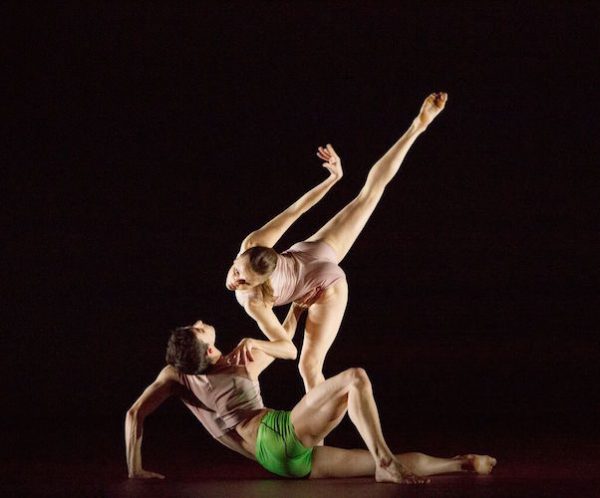Dance Review: “Atomos” — Way Overagitated
Despite its grand intentions, Atomos is essentially an abstract work that springs from McGregor’s obvious passion for full-throttle movement.
Atomos, Wayne McGregor. Presented by Celebrity Series at the Boch Center/ Shubert Theatre, Boston, MA. (Closed)

A scene from “Atomos.” Photo: Ravi Deepres.
By Mary Paula Hunter
Wayne McGregor’s full-length Atomos is a high concept choreographic work made up of breathtaking physicality. Based on McGregor’s inquiry into the essence of life — or what it means to be human — the piece showcased brilliant dancers gliding through a hyperkinetic vocabulary with astounding ease. But to what effect? Ultimately, McGregor’s rush of choreography did little to illuminate his ideas.
Despite its grand intentions, Atomos is essentially an abstract work that springs from McGregor’s obvious passion for full-throttle movement. Extreme extension, jumps without preparation, and whirlwinds of turns en dedans make up his palette, along with daring lifts and what eventually becomes a numbing obsession with fluidity.
At the onset, McGregor created an unforgettable segment made up of slithering bodies. Like snakes writhing in a shower of golden light, his cast of six men and four women spooled and unspooled limbs, slipping effortlessly in and out of each other’s grasp. It was a mesmerizing orgy, undoubtedly a vision of the beginning of life — and its primal power would not be matched in what remained of Atomos.
Eventually, McGregor’s relentless permutations of extreme movement exhausted our concentration. Near the end of the piece, the dancers lined up, crossed their arms, and then gestured in unison. Although jarring (and unrelated to anything we’d seen before), the stillness and simplicity of the moment was the necessary contrast missing from most of the work.
Along with an overload of movement, Atomos featured too many collaborators, including a digitized figure to which the real dancers were asked to respond. Essentially, Atomos was overstuffed. Instead of enhancing or sculpting his vision, the collaborators added little to McGregor’s attempt to define how a collection of atoms creates an individual. Over conceptualized costuming (digitized “skins”) read simply as attractive leotards in various hues of bronze.
Most irritating in terms of technology were the 3-D glasses distributed to the audience to enhance the images on screens that were lowered part way through the production. What did you see through the special specs? Nothing but vague images. And it never became clear just how all the computer-generated visuals — abstract shapes and lists of numbers — related to the concept of humanity McGregor was ostensibly exploring.
Finally, the backdrop of monochromatic sound created by Dustin O’Halloran and Adam Wiltzie specially for this project was so bland it worked against choreography fighting to define itself. Dancers, the saviors of Atomos throughout, poured themselves into a work of unvarying motion, executing each movement with jaw-dropping skill.
Mary Paula Hunter lives in Providence, RI. She’s the 2014 Pell Award Winner for service to the Arts in RI. She is a choreographer and a writer who creates and performs her own text-based movement pieces.
